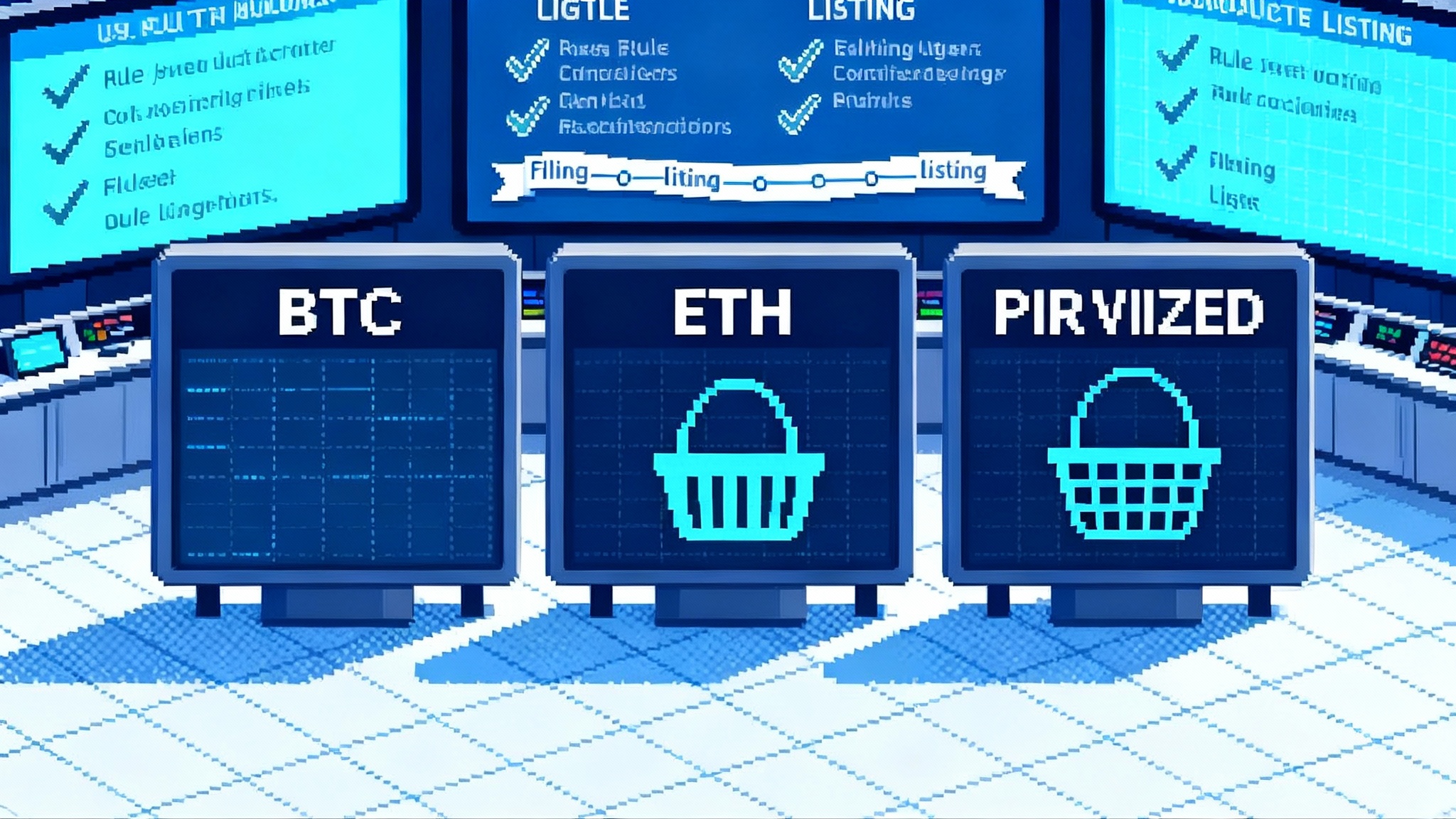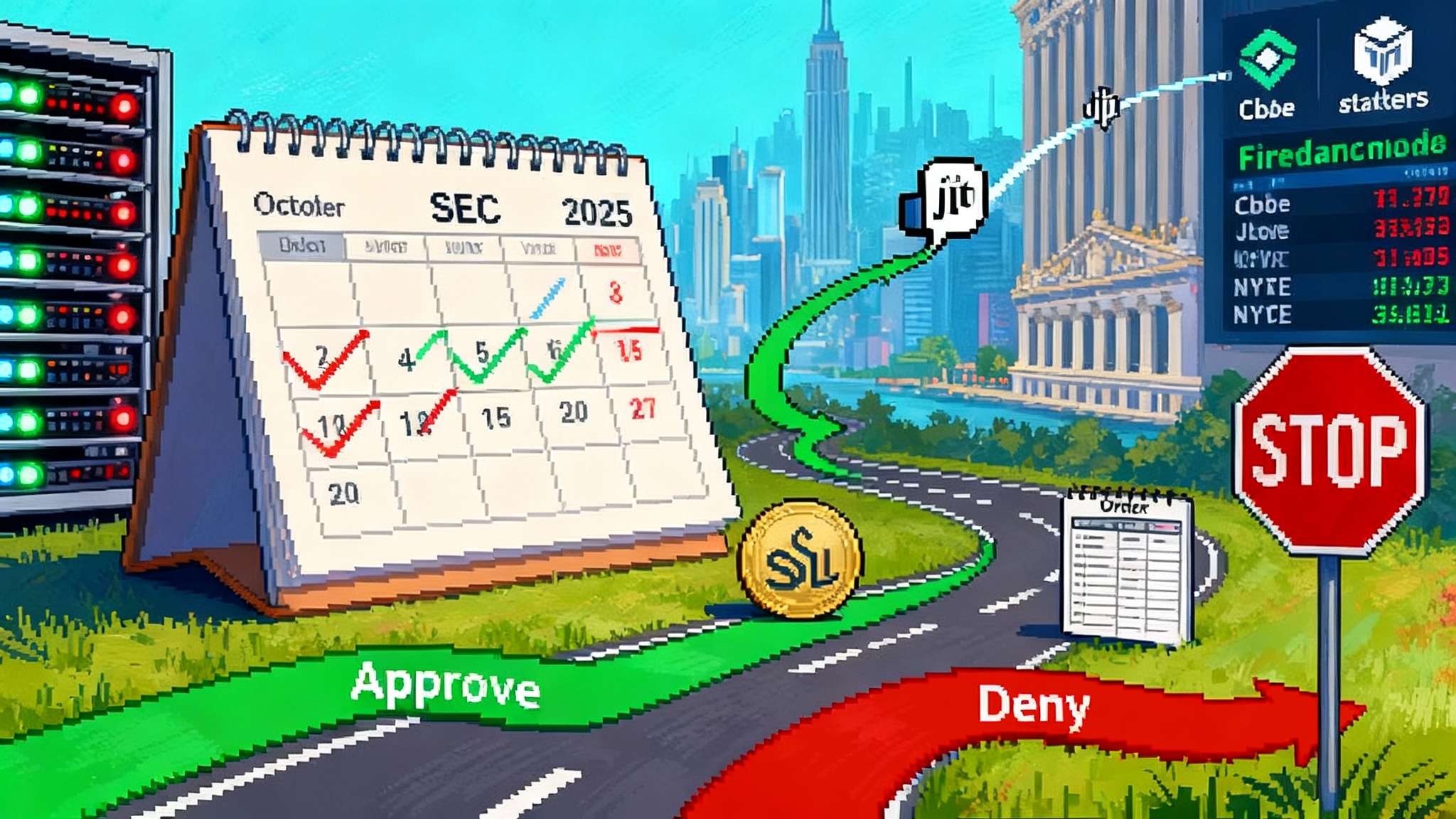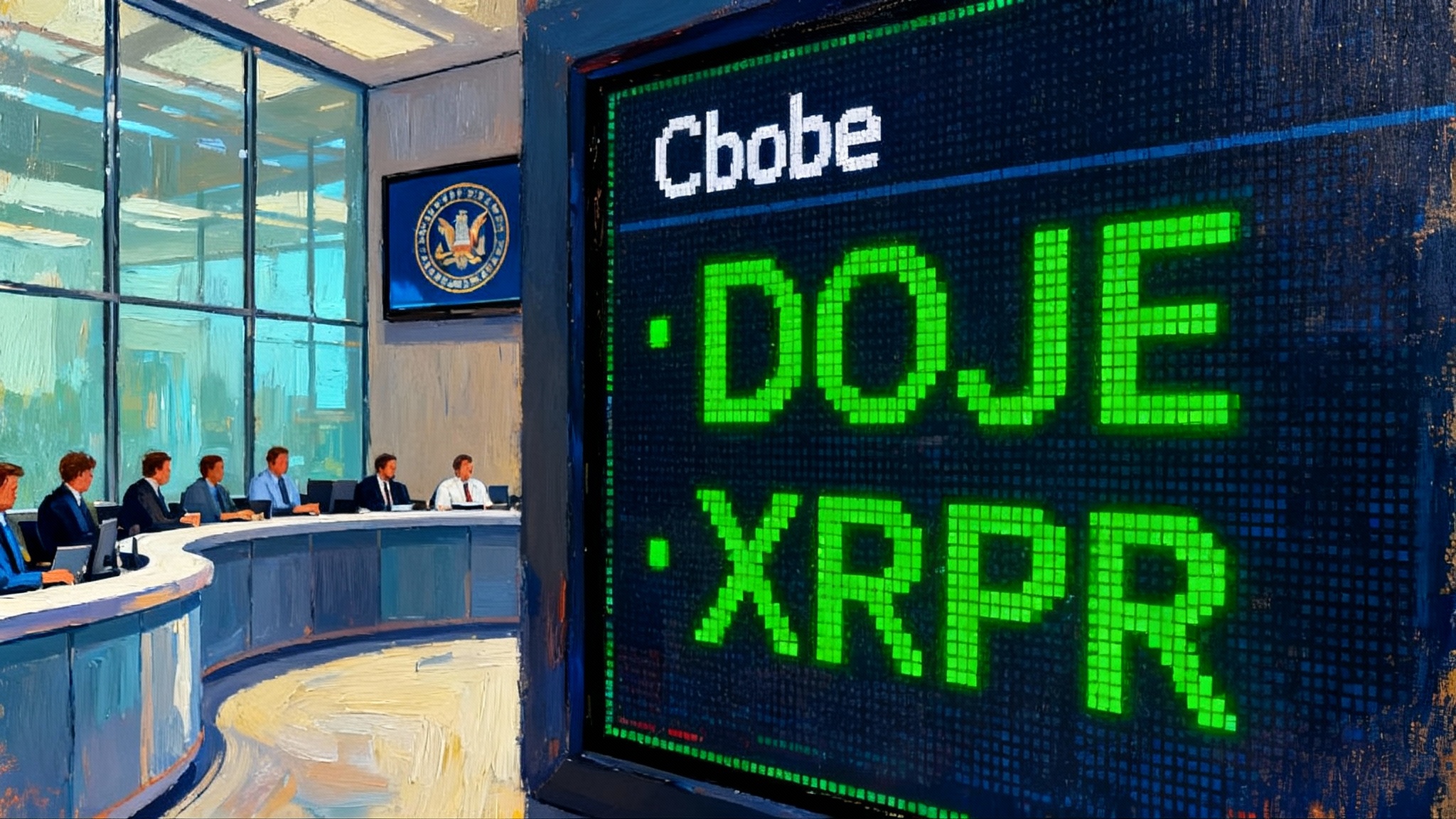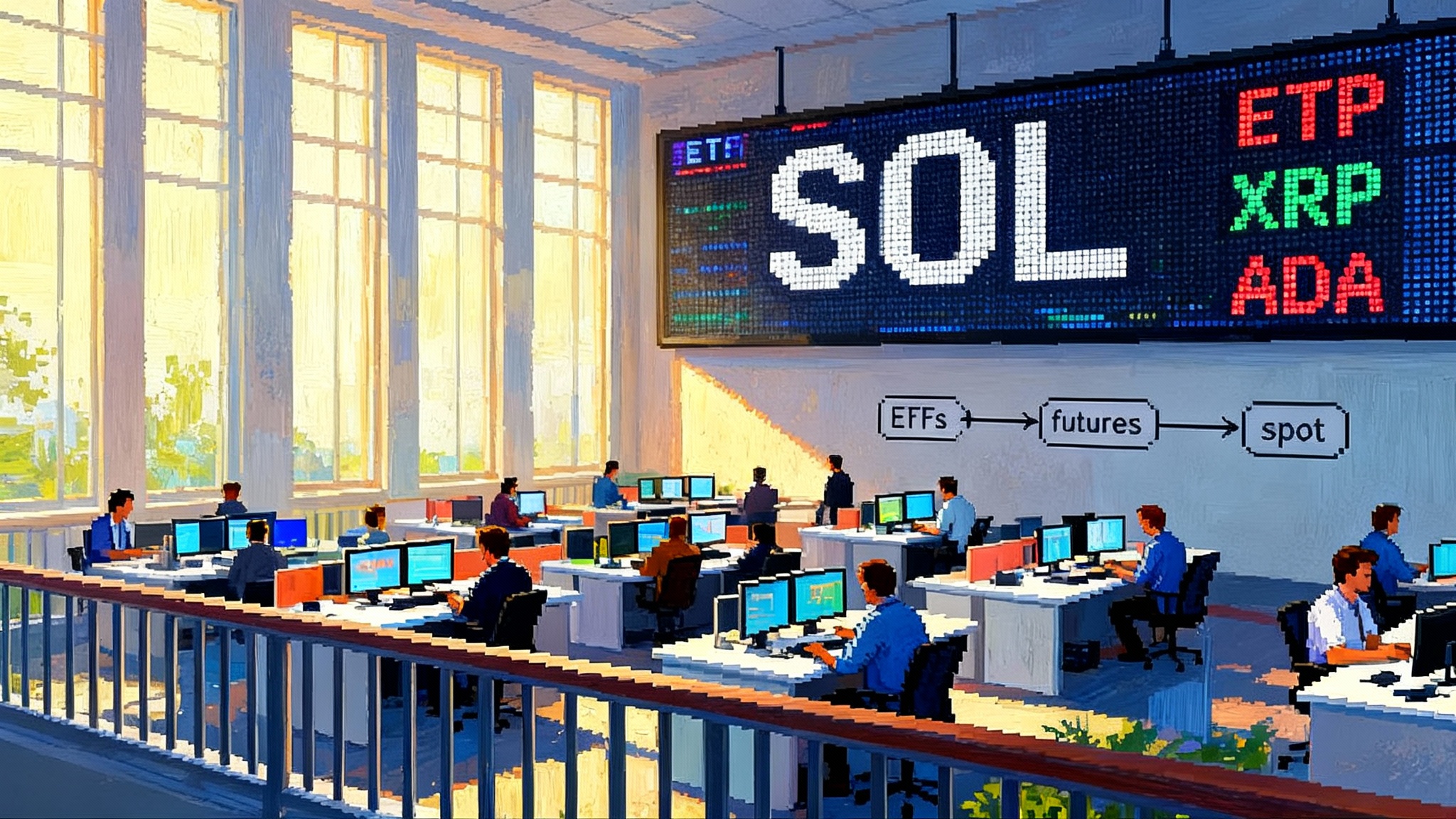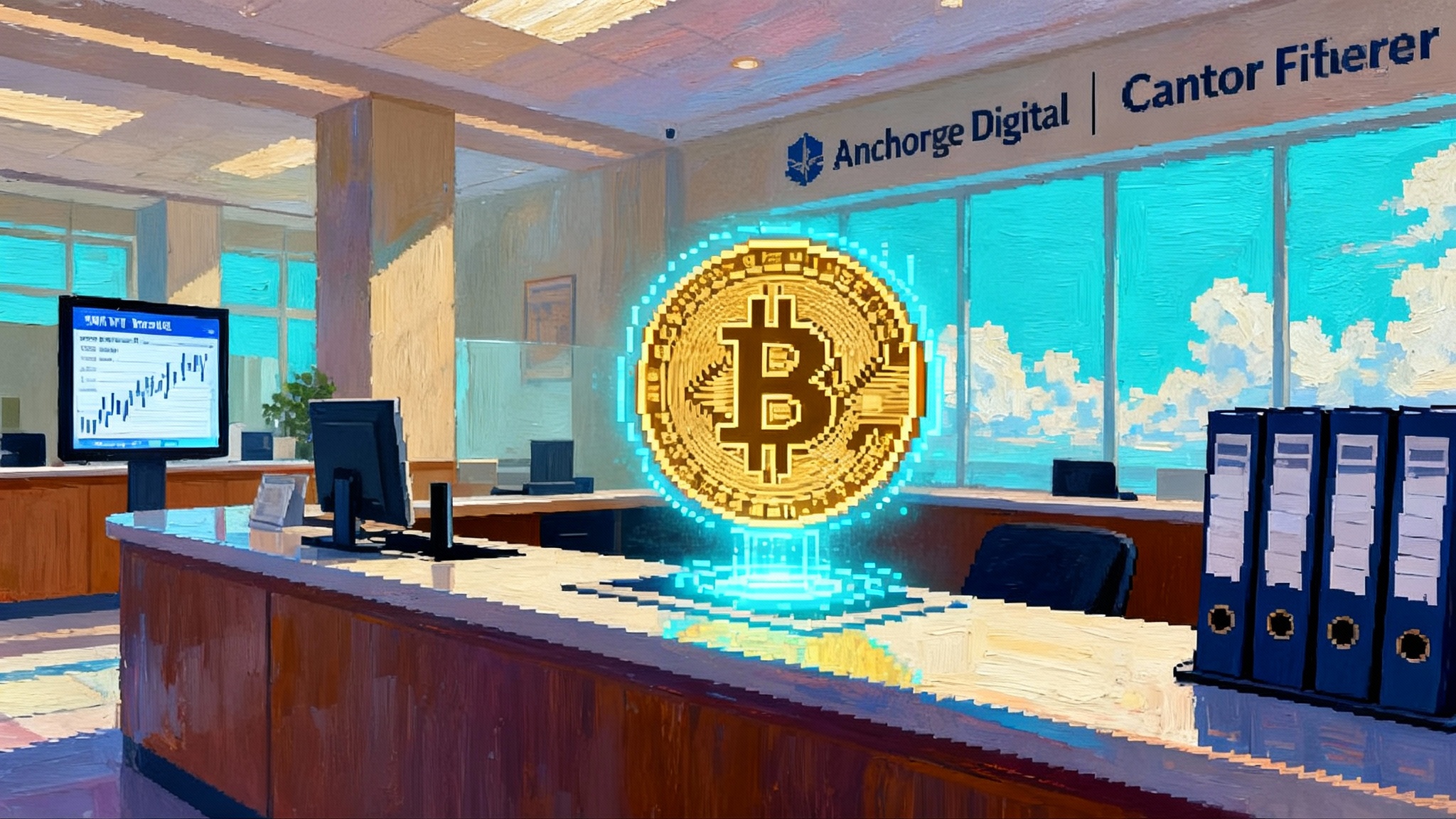SEC’s generic rules open floodgates for crypto spot ETFs
The SEC just approved generic listing standards that let NYSE, Nasdaq, and Cboe list spot digital asset ETPs without bespoke 19b-4 orders. Timelines compress to roughly 75 days and the first wave could include Solana, XRP, and diversified baskets as soon as October.

What just changed, in plain English
On September 18, 2025, the SEC approved generic listing standards that let NYSE Arca, Nasdaq, and Cboe list spot commodity ETPs that hold digital assets without case by case approvals. Until now, every spot crypto fund needed its own 19b-4 exchange rule change and comment cycle. That dual track slog (one filing from an exchange to list the product and one from the issuer to register the shares) could stretch to eight months or more. Under the new framework, exchanges can list qualifying spot digital asset ETPs under preapproved standards, shrinking the timeline to roughly 75 days from filing to potential launch and widening access beyond bitcoin and ether. For quick context, see Reuters coverage of the vote, and check our ETF rules explainer for a deeper walkthrough.
The old approach forced bespoke legal arguments about surveillance and market integrity for each asset. The new approach standardizes the bar so that if a product and its reference market meet objective criteria, the exchange lists it. Issuers still need their registration statements declared effective, but they no longer wait for an exchange bylaw change tied to a single product.
How funds can qualify under the new standards
Think of the new rule set as three doors. Walk through any one of them and your ETP is eligible for exchange listing under generic standards.
- Futures link door
- If a futures contract on the underlying asset has traded on a CFTC regulated designated contract market for at least six months, that is enough. This was the path that unlocked bitcoin and ether via CME and can expand as more regulated futures exist. Expect many issuers to anchor filings to this pathway because it is clean and auditable.
- Surveillance door
- If the commodity trades on a market that participates in the Intermarket Surveillance Group or otherwise enables the exchange to maintain a comprehensive surveillance sharing program over a market of significant size, that can satisfy the anti manipulation standard. In practice, exchanges will lean on cooperative market data access and credible pricing benchmarks rather than one-off attestations.
- Bootstrap door via 40 Act ETF exposure
- If there is already an ETF listed on a national securities exchange with at least 40 percent of its NAV providing exposure to the same commodity, that presence can serve as the qualifying condition that lets commodity ETPs that hold the asset list under the generic standards. This bridges the 1940 Act ETF regime and 33 Act commodity ETPs and reduces duplication when a market already has meaningful listed exposure.
For the SEC’s own framing, see Peirce's statement on standards.
Two other nuts and bolts details matter for issuers:
- Exchanges must post specified information on their websites within five business days after trading begins, including objective data about the product and its holdings.
- If a product does not fit the new generic standards, an exchange can still pursue the traditional 19b-4 route. Generic standards are a fast lane, not the only lane.
Why the first wave could include Solana, XRP, and baskets
Who goes first is a function of readiness and eligibility. For single asset funds, Solana and XRP stand out because they already have deep spot liquidity, active U.S. investor demand, and issuers have been prepping prospectuses and service provider stacks for over a year. Reuters noted that exchanges and counsel expect those two to lead and that October launches are possible if paperwork and operational checks clear quickly. For a detailed view on scenarios, see Solana ETF scenarios for October.
Multi asset baskets may sprint alongside them because they can diversify idiosyncratic risk, reuse tested index and pricing methodologies, and fit neatly into the generic standards disclosure and surveillance framework.
There is also a practical reason baskets will come early. Market makers can hedge a diversified index with a mix of the most liquid majors and CME futures, reducing basis risk and making creation redemption more predictable on day one. Several issuers have turnkey index relationships and shelf registration language ready for multi asset exposures, which shortens the last mile. For mechanics, see our take on multi-asset ETFs and in-kind flows.
Mapping the new product lanes
Expect three broad categories in the first 30 to 90 days.
- Single asset spot ETPs
- Likely tickers: SOL, XRP, then ADA, DOGE, LINK, AVAX, LTC as pricing, custody, and reference rates clear internal bars. Early issues will emphasize simple, fully collateralized cold custody with transparent fee structures. Some will target institutional buyers with lower fees and larger creation baskets; others will pursue retail with tighter share prices and stronger brand marketing.
- Diversified baskets
- Large cap five or seven token portfolios weighted by free float market cap with caps to avoid concentration. Equal weight variants will appear to give mid caps more representation. Expect products that explicitly exclude stablecoins, privacy coins, and staking rewards in the first wave to keep operational complexity low.
- Thematics
- Layer 1 smart contract platforms, payment networks, Web3 infrastructure, oracles and data. A memecoin sleeve is not out of the question later, but liquidity, hedging, and reputational risk will make most issuers cautious in the launch quarter. Thematic baskets are an easy landing zone for managers with research driven narratives who want differentiation without betting on a single chain.
The operational hurdles that still matter
This is not a green light to list anything overnight. Here are the main potholes issuers must avoid.
-
Custody at scale: Cold storage with robust key ceremony controls, SOC 2 audits, insurance for crime and specie, and independent verification of on chain addresses are table stakes. Multi asset custody means more complex wallet infrastructure and more hot cold rebalancing risk. Expect a small set of battle tested custodians at the start, with some issuers using dual custody to mitigate single point risk.
-
Market maker and authorized participant readiness: Trading desks need reliable borrow, clear hedging avenues, and a clean operational pipe for in kind or cash creates. For several tokens, borrow markets are thin or fragmented. Expect initial funds to default to cash creations with the issuer responsible for acquisition until prime brokers and APs certify smooth operational flow.
-
Index design and reference rates: Good benchmarks are manipulation resistant and operationally resilient. Most issuers will aggregate volume weighted prices from a curated set of spot venues during a short calculation window and include hard filters for outliers and wash trading. Monthly or quarterly reconstitution with drift buffers is more realistic than daily for live trading.
-
Pricing and fair value: Because crypto trades around the clock while ETFs do not, NAV at the close must reflect a fair value policy for after hours moves. ETF operations teams will lean on independent pricing agents to implement model based adjustments to the 4 p.m. close when crypto markets are volatile.
-
Disclosure and risk language: Prospectuses will carry blunt language about volatility, forks, airdrops, and regulatory actions. Most will disclaim participation in staking or protocol level rewards at launch to simplify tax and operational risk.
-
Surveillance and data sharing: Exchanges will document surveillance sharing with significant markets and data providers, spelling out how they detect and deter manipulation tied to the reference rates. The generic standards make this framework repeatable, which is the real win.
Who stands to win in the next 30 to 90 days
-
Exchanges
Cboe BZX has been the home to numerous crypto ETPs and has deep relationships with issuers and market makers that specialize in digital assets. Expect it to capture a large share of early listings. NYSE Arca’s ETF franchise and operational muscle will make it a close challenger. Nasdaq will compete aggressively in baskets and higher profile single asset funds backed by mega issuers. -
Issuers
The incumbents with live bitcoin and ether products and large distribution are best positioned: BlackRock, Fidelity, VanEck, Bitwise, Franklin Templeton, Invesco Galaxy, Ark 21Shares, and Grayscale. They have ready index relationships, standing AP lines, and custody integrations. The first to file with clear eligibility narratives and clean service provider stacks will win mindshare and assets. Smaller managers can still carve niches by being first in a theme or cutting fees, but they face an uphill climb on shelf space and liquidity. -
Custodians and pricing agents
Coinbase Custody, Fidelity Digital Assets, Anchorage, BitGo, and Gemini stand to onboard new mandates quickly. On the benchmark side, CF Benchmarks, CoinDesk Indices, MarketVector, FTSE Russell, and Nasdaq will see demand for compliant, transparent, and surveilled reference rates and index methodologies. -
Market makers and APs
Desks like Jane Street, Virtu, Flow Traders, and Susquehanna that already hedge crypto baskets and futures will be crucial to stable spreads at launch. The winners will be the firms that can commit seed capital, turn around creations quickly, and provide continuous two sided markets during stress. -
Layer 1 ecosystems
Solana and XRP are set to benefit from the first listings because indexed and single asset flows will concentrate in the most liquid names at the start. Ethereum and bitcoin remain the liquidity anchors for hedging and basket construction. Second tier assets with solid reference rates and custody coverage, like ADA and LINK, are early candidates for the follow on wave.
Who could lose ground
-
Late filing issuers and fee takers
Generic standards lower the barrier but intensify competition. Managers without clear differentiation or distribution may struggle to reach scale and may be cut from platforms. Fees will compress quickly toward the leaders. -
Tokens without clean eligibility stories
Assets that lack credible pricing, reliable custody, or clear legal and surveillance narratives will sit on the sidelines while capital concentrates in majors and clean mid caps. Liquidity begets liquidity in ETF land. -
Exchanges without crypto muscle memory
Listing is only half the battle. Exchanges that cannot demonstrate enforcement ready surveillance integration, crisp market data dissemination, and crypto aware market operations may find issuers steering listings elsewhere.
The 30, 60, 90 day roadmap
-
Days 0 to 30
Exchanges publish their generic standards playbooks. Issuers convert pending filings to the new pathway. APs and market makers run test creations. Prospectuses get tightened with final fee, index, and service provider disclosures. Marketing teams line up education and risk content for advisors and wealth platforms. -
Days 30 to 60
First single asset funds launch, with Solana and XRP the likeliest candidates. One or two diversified baskets debut targeting large cap exposure. Five to ten additional filings queue up under the futures and surveillance pathways. Fee wars begin. -
Days 60 to 90
Second wave of single asset ETPs fills out the top ten market cap list. More thematic baskets arrive as index IP gets standardized. Spreads tighten as inventory and borrow improve. Platforms add model portfolios that include a capped crypto sleeve using the new funds.
What this means for investors
For the first time, U.S. investors can expect a menu of crypto exposures that looks like the equity ETF shelf. Single names, broad market baskets, and focused themes will be available through familiar brokerage rails. The structural advantages of exchange listed products such as intraday liquidity, transparent pricing, and familiar tax reporting meet the digital asset market. Risks do not disappear. They become easier to price and rebalance around.
Two pragmatic suggestions if you plan to allocate:
- Start with baskets unless you have conviction and diligence on a specific chain’s roadmap. Baskets reduce idiosyncratic risk and operational surprises.
- Read the prospectus sections on custody, pricing, and creations. These are where funds differ most in ways that matter during stress.
The bigger picture
This is not just a green light for more tickers. It is a signal that digital assets are being slotted into the machinery of U.S. capital markets using guardrails similar to precious metals and other commodities. The SEC has moved from bespoke judgment calls to codified eligibility. That shift should encourage better products, cleaner surveillance, and faster iteration. It will not end debate about investor protection, but it moves that debate to where it belongs, the transparency of rulebooks rather than one off orders.
If October brings the first Solana and XRP spot funds and a couple of diversified portfolios, it will mark the start of a more orderly, competitive market for crypto exposure. The floodgates are opening. The winners will be those who build for reliability and simplicity, not just speed.


